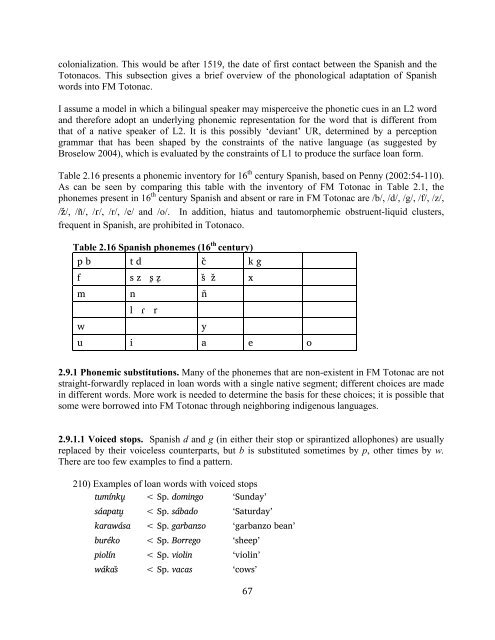The phonology and morphology of Filomeno Mata Totonac
The phonology and morphology of Filomeno Mata Totonac
The phonology and morphology of Filomeno Mata Totonac
You also want an ePaper? Increase the reach of your titles
YUMPU automatically turns print PDFs into web optimized ePapers that Google loves.
colonialization. This would be after 1519, the date <strong>of</strong> first contact between the Spanish <strong>and</strong> the<br />
<strong>Totonac</strong>os. This subsection gives a brief overview <strong>of</strong> the phonological adaptation <strong>of</strong> Spanish<br />
words into FM <strong>Totonac</strong>.<br />
I assume a model in which a bilingual speaker may misperceive the phonetic cues in an L2 word<br />
<strong>and</strong> therefore adopt an underlying phonemic representation for the word that is different from<br />
that <strong>of</strong> a native speaker <strong>of</strong> L2. It is this possibly ‘deviant’ UR, determined by a perception<br />
grammar that has been shaped by the constraints <strong>of</strong> the native language (as suggested by<br />
Broselow 2004), which is evaluated by the constraints <strong>of</strong> L1 to produce the surface loan form.<br />
Table 2.16 presents a phonemic inventory for 16 th century Spanish, based on Penny (2002:54-110).<br />
As can be seen by comparing this table with the inventory <strong>of</strong> FM <strong>Totonac</strong> in Table 2.1, the<br />
phonemes present in 16 th century Spanish <strong>and</strong> absent or rare in FM <strong>Totonac</strong> are /b/, /d/, /g/, /f/, /z/,<br />
/z"/, /ñ/, /$/, /r/, /e/ <strong>and</strong> /o/. In addition, hiatus <strong>and</strong> tautomorphemic obstruent-liquid clusters,<br />
frequent in Spanish, are prohibited in <strong>Totonac</strong>o.<br />
Table 2.16 Spanish phonemes (16 th century)<br />
p b t d c" k g<br />
f s z s, z, s" z" x<br />
m n ñ<br />
l $ r<br />
w y<br />
u i a e o<br />
2.9.1 Phonemic substitutions. Many <strong>of</strong> the phonemes that are non-existent in FM <strong>Totonac</strong> are not<br />
straight-forwardly replaced in loan words with a single native segment; different choices are made<br />
in different words. More work is needed to determine the basis for these choices; it is possible that<br />
some were borrowed into FM <strong>Totonac</strong> through neighboring indigenous languages.<br />
2.9.1.1 Voiced stops. Spanish d <strong>and</strong> g (in either their stop or spirantized allophones) are usually<br />
replaced by their voiceless counterparts, but b is substituted sometimes by p, other times by w.<br />
<strong>The</strong>re are too few examples to find a pattern.<br />
210) Examples <strong>of</strong> loan words with voiced stops<br />
tumínku& < Sp. domingo ‘Sunday’<br />
sáapatu& < Sp. sábado ‘Saturday’<br />
karawása < Sp. garbanzo ‘garbanzo bean’<br />
buréko < Sp. Borrego ‘sheep’<br />
piolín < Sp. violin ‘violin’<br />
wákas" < Sp. vacas ‘cows’<br />
! *+!

















